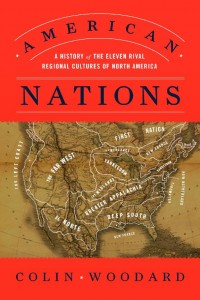 Colin Woodard’s American Nations: A History of the Eleven Rival Regional Cultures of North America is a scholarly study of the eleven “nations” that make America what it is today.
Colin Woodard’s American Nations: A History of the Eleven Rival Regional Cultures of North America is a scholarly study of the eleven “nations” that make America what it is today.
We often think of the forming of America as immigration developing from east to west, expanding from the English beachheads of Massachusetts and Virginia to the shores of the Pacific. In truth, the European culture first arrived from the south, borne by the soldiers and missionaries of Spain. From American Nations, the reader discovers that many of the things learned in history classes were not quite accurate; in some cases, far from reality.
In the development America, virtually no consideration was made toward the people who already resided throughout the land, the Native Americans. The indigenous cultures before immigration often had a higher standard of living than their European counterparts. They tended to live in a healthier environment, some had public water supplies fed by stone aqueducts. The Native people had organized continent-spanning trade networks. Epidemics brought by foreigners, warfare, and their being forced to live in unsuitable areas diminished Native American populations and influence to only a small fraction of what they once were.
The states as we know them today do not define America. The eleven nations, or regional cultures, more clearly define the United States of America: Yankeedom, New Netherland, The Midlands, Tidewater, Greater Appalachia, The Deep South, New France, El Norte, Left Coast, Far West, First Nations. Some of these nations now spread into Canada and Mexico. The book contains a map which clearly defines the regions, as does the book’s cover.
Each of the founding nations are steeped in their own cultures and cherished principles, often contradicting one another.
American Nations delves into the different philosophies of our country’s regions and what it is about the dissimilarity that causes the challenges we face today in uniting our country.
I found American Nations fascinating. Woodard presents compelling explanations of the regional differences that make up America’s cultural and political landscape. It becomes clear why twenty-first century northern Democrats and Republicans have far more in common with one another than with their counterparts of the south. Values that one region holds dear aren’t necessarily shared in other parts of the country.
To learn more about Colin Woodard, award winning author and journalist, visit colinwoodard.com


This looks fascinating. Will look into it.
It is interesting. Although it’s about Camano Island, it’s a good example of what others can do to preserve nature in their areas. Thanks, Carmen.
Oh, my mistake, Carmen. I thought you were commenting on today’s blog. Yes, American Nations is really a good read–you’d like it.
Thank you for this, Mary. It looks to be a good asset for writers’ of historical fiction. I’ll look into getting a copy soon.
Thanks for this mention, it mudged me to order a copy and I very much look forward ti reading it. Two notes: Technically, North America include Mexico. Strange that the author apparently (judging from the map on the book’s cover) left that out. But maybe it was just too much to tackle. And it seems to me that Texas (Far West Texas is the subject of my book-in-progress) is a blend of cultures: Southern, Western, Tex-Mex and Yankee– lots of retirees roaming around out there. Hmm… lots to think about… very interesting…
Sounds very interesting. I’ll have to get a copy for myself and tell my oldest daughter about it. Thanks, Mary.
Eunice, my sister-in-law recommended it to me. The book is very absorbing.